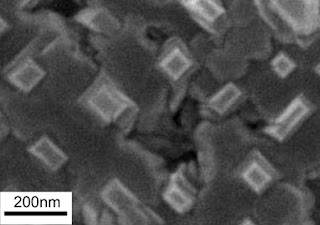Duet on nano-style
Scientist have in mind since long a system depending on a combined use of ferroelectric and magnetic properties. A team from the Center for Nano Integration (CENIDE) at the University of Duisburg-Essen (UDE) has recently succeeded in such a composite system. Their results are published in the current issue of Nature Communications ("In-plane electric polarization in multiferroic CoFe2O4 / BaTiO3 nanocomposite tuned by magnetic fields").
 |
| A scanning electron micrograph of the nanocomposite in the plan |
By the late 1950s it was predicted by the American physicist and Nobel prize Richard Feynman, that all knowledge of the world could eventually be stored in a memory the size of a small grain of sand. Although we now already bring terabytes below the volume of a lunch box, during the first computer era 70 years ago with only a few kilobytes of memory riempivano interi edifici. But today's possibilities have limits - the system is not any more to reduce or accelerate. So forth we need new techniques for more complex requirements.
CENIDE scientists deal with research that could at once form the basis of new storage media: The system examined by the team led by experimental physicists Prof. Dr. Heiko Wende, Prof. Dr. Wolfgang Kleemann and Dr. Carolin Schmitz-Antoniak consists of a layer of barium titanate, in the tiny, only a few nanometers wide pillars are embedded within cobalt ferrite. Both components of this composite are different: the columns are ferromagnetic, i.e. they can be similar to small compass needles indicating a magnetic field. In addition, they can be deformed by the magnetic field. However, the surrounding layer, also called matrix, is based on a ferroelectric electric voltage when under mechanical pressure. This so-called "piezoelectric effect" is used incidentally also without flint lighters: when pressing the button a spring suggests a plunger on the piezo-crystal, creating a large voltage. The result is applied to the metal and a contact spark ignites the lighter gas.
The objective of scientists is to deform the nanoscale columns via a magnetic field and thus exert mechanical pressure on the matrix. It also relate to the "magneto-electric coupling of a multiferroic composite system", a worldwide research topic with high relevance to application. The magneto-electric coupling is actually based on the tiniest movements of the atoms in the composite; if I create columns along the long axis of a magnetic field, then the pillars pull together in this direction. Its circumference is increased thereby to keep the volume constant, and so they press on all sides of the surrounding matrix. Pressure builds on this voltage.
On the other hand, the magnetic field runs perpendicular to the columns, to pull this together in the field direction, while they expand across it. Thus, the matrix is compressed only transversely to the magnetic field and forms an asymmetric distribution of electrical polarization, which has not been previously observed in this system. The experimental demonstration has been made possible by the scientific cooperation with Dr. Detlef Schmitz and other researchers of the Helmholtz Centre Berlin for Materials and Energy (HZB).
For digital data storage, the system of interest is characterized by the fact that the electric polarization is obtained even when the magnetic field is switched off again. Thus, the researchers have already developed a strategy to compress individual columns by current pulses in longitudinal and transverse direction targeted to enroll as information bit by bit.
In principle, the technique should also work reversed only by an electric voltage, without flow of current, the magnetization direction can be changed and so a bit can be written. The readout of the information would be possible as yet about the magnetic structure.
"Of course we are talking about future music," said the group leader, "but the magnetoelectric memory principle offers fundamental advantages."
So it is very energy efficient in the long run, because only voltage, but no current flow is needed. In this way, no heat would be produced, which would be extremely harmful, especially for the data security of extremely densely packed storage elements.
Magnetoelectric memory also function as opposed to some other high-tech visions without additional cooling at room temperature and protect the data stored in them extremely stable. Until compressed magnetic nanopillars actually protect our data, but many memory cells are not erased and rewritten.
Source: University of Duisburg-Essen
Translation. R F Grassi
Found here http://www.nanowerk.com/news2/newsid=31057.php
